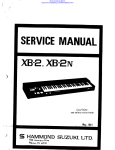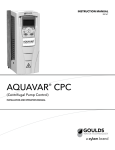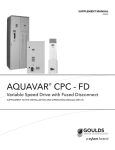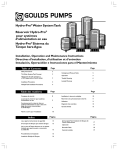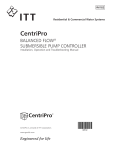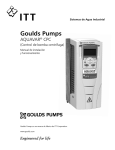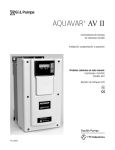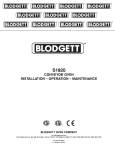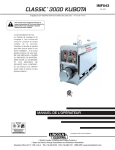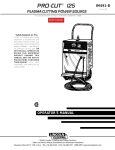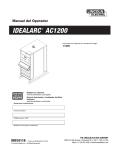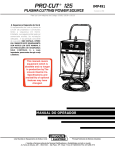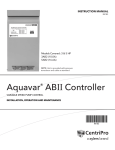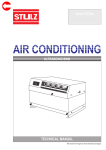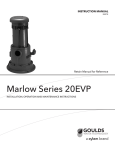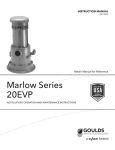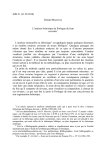Download Service Manual - Depco Pump Company
Transcript
Service Manual SUBMERSIBLE PUMPS • JET PUMPS GSSERVICE TABLE OF CONTENTS Submersibles: (Pages 1 – 61) Page Safety Warnings.............................................................. 1-3 Typical Systems............................................................... 4-5 Motor Cooling.................................................................... 6 Troubleshooting.............................................................. 7-9 Amprobe Instructions...................................................... 10 Ohmmeter Instructions................................................... 11 Measuring Insulation Resistance.................................... 12 Coil Checkout................................................................... 13 Relay Checkout...........................................................14-15 Contactor Checkout........................................................ 16 Overload Checkout......................................................... 17 Capacitor Checkout......................................................... 18 Fuse Checkout.................................................................. 19 Voltage Checkout.......................................................20-23 Amperage Checkout..................................................24-25 Wire Diagrams............................................................26-31 Cable Checkout..........................................................32-33 Motor Insulation & Winding Resistance...................34-37 1Ø Motor Data and Wire Sizing................................38-43 3Ø Motor Data and Wire Sizing................................44-49 Aquavar SOLO Wire Sizing........................................50-51 3Ø 6" – 10" Motor Data..............................................52-55 Pressure Tank Checkout.............................................56-57 Jet Pumps: (Pages 58 – 92) Typical Systems...........................................................58-59 Jet Pumps....................................................................60-63 Troubleshooting..........................................................64-69 Voltage Check.................................................................. 70 Amperage Checks......................................................71-72 Ohmmeter Checks.....................................................73-79 Pressure Switch Adjustment Checkout......................... 80 Checking Suction Lift..................................................81-82 Pressure Control Valves................................................... 83 Rotation............................................................................. 84 Three Phase Unbalance.............................................85-86 Transformer Sizes........................................................87-88 Quick Start Guides......................................................89-92 TO AVOID SERIOUS OR FATAL PERSONAL INJURY OR MAJOR PROPERTY DAMAGE, READ AND FOLLOW ALL SAFETY INSTRUCTIONS IN MANUAL AND ON PUMP. THIS MANUAL IS INTENDED TO ASSIST IN THE INSTALLATION AND OPERATION OF THIS UNIT AND MUST BE KEPT WITH THE PUMP. This is a SAFETY ALERT SYMBOL. When you see this symbol on the pump or in the manual, look for one of the following signal words and be alert to the potential for personal injury or property damage. of hazards that WILL cause DANGER Warns serious personal injury, death or major property damage. WARNING Warns of hazards that CAN cause serious personal injury, death or major property damage. Warns of hazards that CAN cause perCAUTION sonal injury or property damage. NOTICE: INDICATES SPECIAL INSTRUCTIONS WHICH ARE VERY IMPORTANT AND MUST BE FOLLOWED. THOROUGHLY REVIEW ALL INSTRUCTIONS AND WARNINGS PRIOR TO PERFORMING ANY WORK ON THIS PUMP. MAINTAIN ALL SAFETY DECALS. 1 SAFETY WARNINGS Safety Warnings SAFETY WARNINGS Important notice: Read safety instructions before proceeding with any wiring. WARNING All electrical work must be performed by a qualified technician. Always follow the National Electrical Code (NEC), or the Canadian Electrical Code, as well as all local, state and provincial codes. Code questions should be directed to your local electrical inspector. Failure to follow electrical codes and OSHA safety standards may result in personal injury or equipment damage. Failure to follow manufacturer’s installation instructions may result in electrical shock, fire hazard, personal injury or death, damaged equipment, provide unsatisfactory performance, and may void manufacturer’s warranty. WARNING Standard units are not designed for use in swimming pools, open bodies of water, hazardous liquids, or where flammable gases exist. Well must be vented per local codes. See specific pump catalog bulletins or pump nameplate for all agency Listings. WARNING Disconnect and lockout electrical power before installing or servicing any electrical equipment. Many pumps are equipped with automatic thermal overload protection which may allow an overheated pump to restart unexpectedly. WARNING Never over pressurize the tank, piping or system to a pressure higher than the tank's maximum pressure rating. This will damage the tank, voids the warranty and may create a serious hazard. WARNING Protect tanks from excessive moisture and spray as it will cause the tank to rust and may create a hazard. See tank warning labels and IOM for more information. WARNING Do not lift, carry or hang pump by the electrical cables. Damage to the electrical cables can cause shock, burns or death. WARNING Use only stranded copper wire to pump/ motor and ground. The ground wire must be at least as large as the power supply wires. Wires should be color coded for ease of maintenance and troubleshooting. 2 3 SAFETY WARNINGS Install wire and ground according to the National Electrical Code (NEC), or the Canadian Electrical Code, as well as all local, state and provincial codes. WARNING Install an all leg disconnect switch where required by code. WARNING The electrical supply voltage and phase must match all equipment requirements. Incorrect voltage or phase can cause fire, motor and control damage, and voids the warranty. WARNING All splices must be waterproof. If using splice kits follow manufacturer’s instructions. WARNING Select the correct type and NEMA grade junction box for the application and location. The junction box must insure dry, safe wiring connections. WARNING All motors require a minimum 5' submergence for proper refill check valve operation. WARNING Failure to permanently ground the pump, motor and controls before connecting to power can cause shock, burns or death. WARNING All three phase (3Ø) controls for submersible pumps must provide Class 10, quick-trip, overload protection. WARNING 4" motors ≥ 2 HP require a minimum flow rate of .25 ft/sec. or 7.62 cm/sec. past the motor for proper motor cooling. The following are the minimum flows in GPM per well diameter required for cooling: 1.2 GPM/4", 7 GPM/5", 13 GPM/6", 20 GPM/7", 30 GPM/8" or 50 GPM in a 10" well. WARNING Pumps ≥ 2 HP installed in large tanks should be installed in a flow inducer sleeve to create the needed cooling flow or velocity past the motor. DANGER TYPICAL SYSTEM Two-Wire System Illustrated RULE OF THUMB 1. 2. Use same size or larger pipe as discharge on pump. Always use a check valve for every 200 ft. of vertical pipe. To House Piping Protected Power Supply Disconnect Switch Shut-off Valve Union Pressure Switch Pressure Relief Valve Drain Tap Pitless Adapter ➀ Check Valve ➀ Tank Tee Frost Level Check Valve ➁ ➀ On installations with a pitless adapter the top check valve should be below the pitless, not at the tank, as the discharge line should be pressurized back to the pitless. ➁ On installations with well seals or well pits it is allowable to locate the top check valve near the tank. CAUTION All electrical equipment must be connected to supply ground. Follow applicable code requirements. 4 TYPICAL SYSTEM Motor Cooling, Temperature and Time Ratings All 4 inch CentriPro motors may be operated continuously in water up to 86º F. Optimum service life will be attained by maintaining a minimum flow rate past the motor of .25 feet per second. Use a Flow Sleeve if velocity is below the .25'/ sec, if the well is top feeding or when the pump is used in a large body of water or large tank. Six (6) inch canned design motors from 5 – 40 HP will operate in water up to 95º F (35º C), without any de-rating of horsepower, with a minimum flow rate of .5 ft./sec. past the motor. 6" – 50 HP and all 8" – 10" motors can operate in 77º F (25º C) water with .5'/sec velocity past FLOW SLEEVE the motor. One way to make a flow sleeve is to install a well seal above the pump discharge and slip a piece of casing over the pump and affix it to the well seal. Drill three holes at 120º intervals on the lower section of the casing and insert (3) screws and nuts through the casing, just touching the motor. Tighten the nuts out against the casing. Insure that the screws do not protrude out too far as you don’t want them catching on well joints. Pump Cooling and Lubrication In addition to motor cooling, another reason to maintain minimum flow rates is pump lubrication. All manufacturers’, either on curves or in selection charts, show minimum flows. This insures that rotating pump parts are properly lubricated to prolong service life and reduce friction. A dead headed pump will super heat water very quickly, and hot water has no lubricity. 5 TECHNICAL DATA Minimum Flow Rates for Proper Motor Cooling 3.75" Dia. CP = FE = CP = Well or 4" CP or 5.5" Dia. 5.38" Dia.7.52" Dia. Sleeve FE Motor 6" CP 6" FE 8" CP Diameter .25'/secMotorMotorMotor (inches) .5'/sec. .5'/sec. .5'/sec. GPM Required 41.2 ––– 57––– 6 13 7 9 – 7 202325 – 8 304145 9 10 50859053 12 80 139140107 14 110198200170 16 150276280313 Multiply gpm by .2271 for m3/Hr. Multiply gpm by 3.785 for l/min. IMPORTANT This manual is intended ONLY for use by professionals familiar with NEC (National Electric Codes) electrical codes and hydraulic and safety procedures of pump installations. 6 Probable Cause 1. Motor thermal protector tripped a. Incorrect control box b. Incorrect or faulty electrical connections c. Faulty thermal protector d. Low voltage e. Ambient temperature of control box/starter too high f. Pump bound by foreign matter g. Inadequate submergence Recommended Action 1. Allow motor to cool, thermal protector will automatically reset 2. Open circuit breaker or blown fuse 2. Have a qualified electrician inspect and repair, as required 3. Power source inadequate for load 4. Power cable insulation damage 5. Faulty power cable splice 3. Check supply or generator capacity 4 – 5. Have a qualified electrician inspect and repair, as required a – e. Have a qualified electrician inspect and repair, as required f. Pull pump, clean, adjust set depth as required g. Confirm adequate unit submergence in pumpage RULE OF THUMB Remember, there may be other system problems caused by auxiliary controls not covered in this booklet. 7 TROUBLESHOOTING Pump Motor Not Running TROUBLESHOOTING Little or No Liquid Delivered by Pump Probable Cause 1. Faulty or incorrectly installed check valve Recommended Action 1. Inspect check valve, repair as required 2. Pump air bound 2. Successively start and stop pump until flow is delivered 3. Review unit performance, check with dealer 3. Lift too high for pump 4. Pump bound by foreign matter 4. Pull pump, clean, adjust set depth as required 5. Pump not fully submerged 5. Check well recovery, lower pump if possible 6. Well contains excessive amounts of air or gases 6. If successive starts and stops does not remedy, well contains excessive air or gases 7. Excessive pump wear 7. Pull pump and repair as required 8. Incorrect motor rotation – 3Ø only. 8. Reverse any two motor electrical leads 8 Probable Cause 1. No power Recommended Action 1. Check for tripped circuit breaker 2. Incorrect voltage 2. Check with voltmeter 3. Defective pressure switch 3. Inspect switch points and wires 4. Loose wire connections 4. Check all connections and splices 5. Cable insulation damaged 5. Perform cable check with ohmmeter 6. Damaged or poor splice 6. Perform cable check with ohmmeter 7. Pump bound by sand or abrasives 7. Pull pump and repair as required Pump Starts Too Frequently. . . Probable Cause 1. Waterlogged tank Recommended Action 1. Check tank pressure when empty of water 2. Check valve broken or stuck open 2. Replace check valve 3. Improper switch setting 3. Adjust switch 4. Improper switch placement 4. Move switch closer to tank 5. Leaks in piping 5. Replace defective pipe 6. Tank too small for pump 6. Install larger tank 9 TROUBLESHOOTING Pump Will Not Start or Run. . . AMPROBE/OHMMETER INSTRUCTIONS The Amprobe is a multi-range, combination ammeter and voltmeter. Voltmeter Scales: 150 Volts 600 Volts Ammeter Scales: 5 Amps 40 Amps 15 Amps 100 Amps 1.When used as an ammeter, the tongs are placed around the wire being measured with the rotary scale on the 100 amp range. Then rotate the scale back to the smaller ranges until an exact reading is indicated. 2. When used as a voltmeter, the two leads are clipped into the bottom of the instrument with the rotary scale on the 600 volt range. If the reading is less than 150 volts, rotate the scale to the 150 volt range to get a more exact reading. 10 CAUTION Use Ohmmeter only with power off. 11 AMPROBE/OHMMETER INSTRUCTIONS The Ohmmeter is used for measuring the electrical resistance of a wire circuit. The unit of measurement is called an Ohm. 1.The knob at the bottom of the Ohmmeter is adjustable through six ranges: RX1 = R x 1 If your ohmmeter RX10 = R x 10 is digital readout RX100 = R x 100 type, refer to the RX1000 = R x 1,000 instructions that RX10K = R x 10,000 came with it. RX100K = R x 100,000 2. The round center knob is for the purpose of adjusting the instrument to zero (0) after clipping the two ohmmeter leads together. This must be done every time the range selection is changed. MEASURING INSULATION RESISTANCE Megger This instrument is used to measure insulation resistance to ground. It consists of a crankturned magneto, on the side of the case, and will give very close readings calibrated directly in ohms. It is cranked at a moderate rate of speed, approximately 120 rpm, until the pointer reaches a steady deflection. 1. If the ohm value is normal, the motor windings are not grounded and the cable insulation is not damaged. 2. If the ohm value is below normal, either the windings are grounded or the cable insulation is damaged. Check the cable at the well seal as the insulation is sometimes damaged by being pinched. 12 COIL CHECKOUT ! WARNING! Open master breaker and disconnect all leads from starter to avoid damage to meter or electric shock hazard. Connect the ohmmeter leads as shown above. Coil with Ohmmeter 1.Set R x 1000. 2.Connect leads as shown. 3.Reading: Should register some value, Approx. 200-1000 ohms. What It Means – Infinity reading indicates coil is open. Zero reading indicates coil is shorted. In either case, the coil should be replaced. A reading of 200-1000 ohms indicates coil is ok. 13 RELAY CHECKOUT Voltage Relay CONTROL BOXES (CENTRIPRO OR F.E.) Checking Relay with Ohmmeter A. Voltage Relay Tests Step 1, Coil Test 1. Meter setting: R x 1,000. 2. Connections: #2 & #5. 3. Correct meter readings: For 115 Volt Boxes: .7 – 1.8 (700 to 1,800 ohms). For 230 Volt Boxes 4.5 – 7.0 (4,500 to 7,000 ohms). 14 RELAY CHECKOUT Voltage Relay CONTROL BOXES (CENTRIPRO OR F.E.) Step 2, Contact Test 1. Meter setting: R x 1. 2. Connections: #1 & #2. 3. Correct meter reading: Zero for all models. B. F.E. Blue Relay - Solid State 1 ⁄3 – 1 HP QD Control Boxes Used from 1994 until present time: Step 1, Triac Test 1. Meter setting: R x 1,000. 2. Connections: Cap and B terminal. 3. Correct meter reading: Infinity for all models. Step 2, Coil Test 1. Meter setting: R x 1. 2. Connections: L1 and B. 3. Correct meter reading: Zero ohms for all models. 15 CONTACTOR CHECKOUT Checkout Procedure for Magnetic and Other Contactors Contactor Coil Test (Disconnect lead from one side of coil) 1. Meter setting: R X 100 2. Connections: Coil terminals 3. Correct meter reading: 180 to 1,400 ohms Contactor Contact Test 1. Meter Setting: R X 1 2. Connections: L1 & T1 or L2 & T2 3. Manually close contacts 4. Correct meter reading: Zero ohms Additional information on troubleshooting and replacement parts for 1Ø Control Boxes is available in the MAID; Motor Application and Installation Manual. It is also available online at www.xyleminc.com/brands/ gouldswatertechnology. 16 1. Set Ohmmeter at “R x 1” 2. Connect the Ohmmeter leads to Terminal #1 and #3 on each Overload Protector. 3. Reading should be not more than 0.5 Ohms maximum on the scale. CSCR or Mag. Contactor Control Box 17 OVERLOAD CHECKOUT For 1½ HP (and Larger) Control Box CAPACITOR CHECKOUT Capacitor with Ohmmeter CAUTION Discharge the capacitor before making this check. (A screwdriver can be used to make contact between capacitor’s posts.) 1.Disconnect leads to capacitor post. 2.Setting: R x 1,000 3.Connect ohmmeter leads to capacitor posts. 4.Reading: Pointer should swing toward zero, then back toward infinity. 18 FUSE CHECKOUT 1. Set R x 1. 2. Connect leads as shown. 3. Reading: Should register zero. What It Means – Zero reading indicates fuse OK. Infinity (∞) reading indicates bad fuse. 19 VOLTAGE CHECKOUT To Check Voltage with “Q.D.” Type Control Box 1. Remove cover to break all motor connections. CAUTION L1 and L2 are still connected to power. 2. To check VOLTAGE: Use voltmeter on L1 and L2 as shown. 3. When checking voltage, all other major electrical appliances (that could be in use at the same time) should be running. 4. If readings are not within the limits (see chart), call your power supplier. Voltage Limits Measured Volts Nameplate ▼ Min.Max. 115V 1Ø 105 125 208V 1Ø 188 228 230V 1Ø 210 250 20 VOLTAGE CHECKOUT 21 VOLTAGE CHECKOUT 3Ø STARTER Checking Voltage at Fused Disconnect and Magnetic Starter ! WARNING! Power is ON during voltage checking. 1.To check voltage: Use voltmeter on L1, L2 and L3 in sequence. Check should be made at four locations. Step 1 Checking incoming power supply. Step 2 Checking fuses. Step 3 Checking contact points Step 4 Checking heaters. 2.When checking voltage, all other major electrical appliances (that could be in use at the same time) should be running. 3.If incoming power supply readings are not within the limits (see chart), call your power supplier. NOTE:Phase to phase – full line voltage. Voltage Limits Measured Volts Name Plate ▼ MinimumMaximum 208V 3Ø 188 228 230V 3Ø 207 253 460V 3Ø 414 506 575V 3Ø 518 632 Phase to neutral – ½ full line voltage. (depending on transformer connection) 22 VOLTAGE CHECKOUT VOLT 600 500 400 300 200 100 0- VOLT 600 500 400 300 200 100 0- 23 CURRENT (AMPERAGE) CHECKOUT ! WARNING! Power is ON during current checking. Using Amprobe 1.Set scale to highest amp range. 2.Connect amprobe around lead as shown. 3.Rotate scale to proper range and read value. 4.Compare value with table. What It Means – Currents above these values indicate system problems. 24 data. Service Factor Amps with Magnetic Contactor Control Boxes 6" Franklin Electric CentriPro 3-Wire 1Ø 3-Wire HPVoltsYelBlackRed Yel Black Red 5 27.5N/A N/A27.517.410.5 7.5 41.0N/A N/A42.140.55.4 230 10 58.0N/A N/A51.047.58.9 15 85.0N/A N/A75.062.516.9 25 CURRENT (AMPERAGE) CHECKOUT Service Factor Amps with QD (½ - 1 HP) or CSCR (1.5 HP & Larger) Control Boxes ① 4" CP F.E. CP F.E. 1Ø 3-Wire 3-Wire 2-Wire2-Wire HPVoltsYelBlackRedYel BlackRedBlack Black ½ 115 12.6 12.6 0 12.0 12.0 0 9.5 12.0 ½ 6.3 6.3 0 6.0 6.0 0 4.7 6.0 ¾ 8.3 8.3 0 8.0 8.0 0 6.4 8.0 1 9.7 9.7 0 9.8 9.8 0 9.1 9.8 1½ 230 11.1 11.0 1.3 11.5 11.0 1.3 11.0 13.1 2 12.2 11.7 2.613.2 11.9 2.6 3 16.5 13.9 5.617.0 12.6 6.0 N/A 5 27.022.010.0 27.5 19.110.8 ① Generation I CentriPro data. See pages 37-41 for Generation II To Fused Disconnect Or Circuit Breaker 3Ø 3 L1 L2 L3 1 L2 Magnetic Starter 3 Phase Starter T1 T2 T3 To Pump Motor Ground Line Load Line Load TYPICAL WIRING DIAGRAMS Magnetic Starter and Pressure Switch Pressure Switch Requires class 10 quick trip “k-heaters” (overloads), or adjustable class 10 overloads such as ESP100, ESP 200 NOTE: Check to be sure proper selection of pressure switch matched to system voltage has been made... refer to catalog data. Check that starter has ground. 26 TYPICAL WIRING DIAGRAMS To Fused Disconnect Or Circuit Breaker 3Ø Magnetic Starter Line Load To Pump Motor Ground Pressure Switch RULE OF THUMB Check that starter has ground. 27 To Fused Disconnect Or Circuit Breaker 3Ø Magnetic Starter 3 L1 L2 L3 1 L2 3 Phase Starter T1 T2 T3 Input Power (As Required By Level Control) To Pump Motor 1 Line Load Line Load TYPICAL WIRING DIAGRAMS Magnetic Starter, Pressure Switch and Liquid Level Control 3 6 9 7 2 Ground Level Control 5 Pressure Switch Lower Upper Ground Electrode NOTE: Check to be sure proper selection of pressure switch matched to system voltage has been made... refer to catalog data. Check that starter has ground. 28 TYPICAL WIRING DIAGRAMS To Fused Disconnect Or Circuit Breaker 3Ø Input Power (As Required By Level Control) Ground Magnetic Starter To Pump Motor Lower Upper Electrode Line Load Ground Pressure Switch 29 TYPICAL WIRING DIAGRAMS 2-Wire Pump Wiring Diagram with PumpSaver Plus 233P 30 31 TYPICAL WIRING DIAGRAMS Standard 3-Wire Control Box Wiring Diagram with PumpSaver Plus 233P CABLE CHECKOUT Checking Cable and Splice 1. Submerge cable and splice in steel barrel of water with both ends out of water. 2. Set ohmmeter selector on RX100K and adjust needle to zero (0) by clipping ohmmeter leads together. 3. After adjusting ohmmeter, clip one ohmmeter lead to barrel and the other to each cable lead individually, as shown. 4. If the needle deflects to zero (0) on any of the cable leads, pull the splice up out of the water. If the needle falls back to (∞) (no reading) the leak is in the splice. 5. If leak is not in the splice, pull the cable out of the water slowly until needle falls back to (∞) (no reading). When the needle falls back, the leak is at that point. 6. If the cable or splice is bad, it should be repaired or replaced. 32 CABLE CHECKOUT Checking Cable and Splice Test O H M S Ohmmeter Set at RX 100K RX100 RX10 RX1 ZERO OHMS RX1000 RX10K RX 100K Attach this Lead to Metal Tank 33 MOTOR INSULATION RESISTANCE 1.Set the scale lever to R x 100K and adjust to 0. CAUTION Open (turn off) master breaker and disconnect all leads from control box or pressure switch (Q-D type control, remove lid) to avoid damage to meter or electric shock hazard. 2.Connect an ohmmeter lead to any one of the motor leads and the other to the metal drop pipe. If the drop pipe is plastic, connect the ohmmeter lead to the metal well casing or ground wire. OHMS R x 100K Drop Cable with Ground Wire 34 R x 100 R x 10 Rx1 ZERO OHMS R x 1000 R x 10K R x 100K Insulation resistance does not vary with rating. All motors of all HP, voltage and phase rating have similar values of insulation resistance. Condition of Motor and Leads A new motor (without drop cable). A used motor which can be reinstalled in the well. Ohms Megohm ValueValue 20,000,000 20.0 (or more) 10,000,000 10.0 (or more) New motor in the well Motor in the well in good condition Insulation damage, locate and repair 2,000,000 2.0 (or more) (or more) 500,000 – 2,000,000 0.5 – 2.0 Less than Less than 500,000.50 What it Means 1. If the ohm value is normal, the motor windings are not grounded and the cable insulation is not damaged. 2. If the ohm value is below normal, either the windings are grounded or the cable insulation is damaged. Check the cable at the well seal as the insulation is sometimes damaged by being pinched. 35 MOTOR INSULATION RESISTANCE Normal Ohm and Megohm Values (Insulation Resistance) Between All Leads and Ground MOTOR WINDING RESISTANCE CHECKOUT 1. Set the scale lever to R x 1 for values under 10 ohms. For values over 10 ohms, set the scale lever to R x 10. Zero balance the ohmmeter as described earlier. ! WARNING! Open master breaker and disconnect all leads from starter to avoid damage to meter or electric shock hazard. Connect the ohmmeter leads as shown below. 2. Connect the ohmmeter leads as shown below. Cable Resistance – Copper Paired Wire Size CableResistance (ohms per foot) 14 .0050 12 .0032 10 .0020 8 .0013 6 .0008 RX100K 4 .0005 2 .0003 Drop 0 .0002 Cable With 00 .00015 Ground Wire 000 .00013 0000 .00010 O H MS RX100 RX10 RX1 ZERO OHMS If aluminum cable is used the readings will be higher. Divide the ohm readings on this chart by 0.61 to determine the actual resistance of aluminum cable. Ground Wire OHMS RX1000 RX10K RX100K RX100 RX10 RX1 Motor Leads ZERO OHMS RX1000 RX10K RX100K RX1 or RX10 See motor data pages for motor resistance ratings. What it Means 1. If all ohm values are normal, the motor windings are neither shorted nor open, and the cable colors are correct. 2. If any one ohm value is less than normal, the motor is shorted. 3. If any one ohm value is greater than normal, the winding or the cable is open or there is a poor cable joint or connection. 4. If some ohm values are greater than normal and some less, the leads are mixed. 36 3-Wire CentriPro Motors Winding Resistance ¹ Generation I Generation II HP Volts Winding Resistance Winding Resistance Main (B-Y) Start (R-Y) Main (B-Y) Start (R-Y) 0.5 115 .9-1.6 5.7-7 1.0-1.4 2.5-3.1 0.5 230 4.2-4.917.4-18.75.1-6.112.4-13.7 0.752302.6-3.611.8-132.6-3.310.4-11.7 1.0 230 2.2-3.211.3-12.32.0-2.6 9.3-10.4 1.52301.6-2.37.9-8.72.0-2.69.3-10.4 2 2301.6-2.210.8-121.6-2.210.8-12.0 32301.1-1.42-2.51.1-1.42.0-2.5 5 230 .62-.761.36-1.66.62-.761.36-1.66 ¹ Generation II 3-wire were introduced in February 2012. 4" Franklin Electric Winding Resistance Winding KVA Type HPVolts ResistanceCode ½ 115 1.0-1.3 R ½ 230 4.2-5.2 R 2-Wire ¾ 230 3.0-3.6 N 1 230 2.2-2.7 N 1½ 230 1.5-1.9 M Type HP Volts 3-Wire ½ 115 ½ w/Q.D. Cap. ¾ Start 1 3-Wire 1½230 w/CSCR 2 (CR) 3 Control 5 Box Resistance KVA Main Start Code (B-Y) (R-Y) 1.0-1.3 4.1-5.1 M 4.2-5.2 16.7-20.5 M 3.0-3.6 10.7-13.1 M 2.2-2.7 9.9-12.1 L 1.7-2.2 8.0-9.7 J 1.8-2.3 5.8-7.2 G 1.0-1.5 3.5-4.4 H .68-1.0 1.8-2.2 F RULE OF THUMB Add resistance of drop cable when checking pump in well. See Cable Resistance. 37 MOTOR WINDING RESISTANCE CHECKOUT Motor Resistance MOTOR DATA 2-Wire PSC, 1Ø, 4" Motors – Electrical Data, 60 Hz, 3450 RPM GENERATION I – 2-Wire CentriPro Motors Resistance, Amps and KVA Code ² HP Volts FLA SF Amps LRA 0.51157.4 9.5 36 0.52303.7 4.7 20 0.75 230 5 6.4 25 1.02307.9 9.1 22 1.52309.2 11 42 Ohms KVA 1.3-1.8 K 4.5-5.2 K 3-4.8 J 4.2-5.2 F 1.9-2.3 H GENERATION II – 2-Wire CentriPro Motors Resistance, Amps and KVA Code ² HP Volts FLA SF Amps LRA 0.51157.9 9.8 28 0.5 230 4 4.7 16 0.75 230 5 6.2 18 1.02306.7 8.1 24 1.5 230 9 10.4 44 Ohms KVA 1.4-2 H 6.1-7.2 J 5.9-6.9 F 4.2-5.2 F 1.8-2.4 H ² Generation I sold up to December 2011, Generation II introduced in December 2011. NOTE: Generation II motors have a -01 suffix on motor nameplate Model No. ex. Gen I = M05412, Gen II = M05412-01. 38 Fuse or Circuit Breaker Amps Type Order No. HP Standard Dual Element Circuit CentriPro Fuse Time Delay Breaker M054210.5 25 15 20 M05422 0.5 15 10 10 2-Wire M074220.75 20 10 15 (PSC) M104221.0 25 15 20 M154221.5 30 15 25 M05411 0.5 30 20 30 3-Wire M054120.5 15 10 15 QD M07412 0.75 20 10 20 (CSIR) M104121.0 25 15 25 M054120.5 15 10 10 M074120.75 20 10 15 M10412 1.0 20 10 15 3-Wire M15412 1.5 30 15 25 CSCR M204122.0 30 20 25 M304123.0 45 25 40 M504125.0 70 40 60 Motor Resistance 1Ø Motors – Winding Resistance Motor Only (Ohms) 6" Motors CentriProFranklin Electric Resistance KVA Resistance KVA Type HPVolts R - Y B - Y R - B Code (B-Y) (R-Y) Code 5 2.17 0.512.63 G .55-.68 1.3-1.7 E 1.40 0.4 1.77 F .36-.50 .88-1.1 F 6" 7.5 230 1Ø 10 1.05 0.3161.31 E .27-.33 .80-.99 E 15 0.68 0.230.85 D .17-.22 .68-.93 E 39 MOTOR DATA 2-Wire and 3-Wire – Fuse and Circuit Breaker Amps MOTOR DATA 3-Wire, 1Ø, 4" Motors Electrical Data, 60 Hz, 3450 RPM Order No. HP Volts SF Type CentriPro 3-Wire with Q.D. Cap. Start Box M05411 0.5 115 1.6 M05412 0.5 1.6 M07412 0.75 1.5 M10412 1.0 1.4 M05412 0.5 1.6 M07412 0.75 230 1.5 3-Wire with CSCR M10412 1.0 1.4 (CR) or M154121.5 1.3 Magnetic Contactor M204122.0 1.25 (MC) Control Box M30412 3.0 1.15 M50412 5.0 1.15 40 11.0/11.0/012.6/12.6/0 50 LRA 8.8/8.8/0 10.9/10.9/0 44 5.5/5.5/06.3/6.3/0 22 5.3/5.3/06.1/6.1/0 21 7.2/7.2/08.3/8.3/0 32 6.6/6.6/07.8/7.8/0 32 8.4/8.4/09.7/9.7/0 41 8.1/8.1/09.4/9.4/0 41 4.1/4.1/2.24.9/4.4/2.1 22 4.2/4.1/1.84.8/4.3/1.8 44 5.1/5.0/3.26.3/5.6/3.1 32 4.8/4.4/2.56.0/4.9/2.3 21 6.1/5.7/3.37.2/6.3/3.3 41 6.1/5.2/2.77.3/5.8/2.6 32 10.9/9.4/41 9.7/9.5/1.4 11.1/11.0/ 489.1/8.2/1.2 1.3 1.1 12.2/11.7/49 9.9/9.1/2.6 12.2/11.7/ 499.9/9.1/2.6 2.6 2.6 14.3/12.0/ 16.5/13.9/ 76 14.3/12.0/ 16.5/13.9/76 5.75.6 5.75.6 24/19.1/27/22/10101 24/19.1/27/22/10 101 10.2 10.2 41 MOTOR DATA Generation I Generation II FL Amps SF Amps FL Amps SF Amps LRA (Y/B/R)(Y/B/R) (Y/B/R)(Y/B/R) 4" 1Ø WIRE SIZING 2-Wire 1Ø Motor Wire Sizing Chart Centripro Motor Lead Lengths - 2 Wire Motors, 1Ø, 4" Motors 60º C & 75º C Insulation - AWG Copper Wire Size Motor Rating HPVolts kWSFA141210 ½ 115 0.37 9.5 115 183 293 ½ 230 0.37 4.7 466 742 1183 ¾ 230 0.55 6.4 342 545 869 1 230 0.75 9.1 241 383 611 1½ 230 1.1 11.0 199 317 505 3-Wire 1Ø Motor Wire Sizing Chart CentriPro Motor Lead Lengths - 3 Wire Motors, 1Ø, 4" Motors 60º C & 75º C Insulation - AWG Copper Wire Size Motor Rating HPVoltskWFLASFA 14 12 10 ½1150.371112.687 138221 ½ 0.37 5.5 6.3 348 553 883 ¾ 0.55 7.2 8.3 264 420 670 1 0.75 8.4 9.7 226 359 573 1½ 230 1.1 9.7 11.1 197 314 501 2 1.5 9.9 12.2 180 286 456 3 2.2 14.3 16.5 133 211 337 5 3.7 24 27 206 Tables based on values from NEC, Tables 310.16 and 310.17 and NEC, Chapter 9, Table 8 Conductor Properties. NOTE: Motors and control boxes are designed to operate on 230V systems. Systems with low line voltage, between 200 – 207 volts require the next larger cable size than shown in the 230V charts. If using a 3-wire motor with control box on a low voltage application switch to a 208V start relay. 42 86 4 21/0 2/0 3/0 4/0 463 721 115018252902366246235824 187429154648737911733 1480318688 23544 137621413413541986171087113724 17290 96815062400381160607646965212160 80112461986315350136325798510060 Based on S.F. Amps, 30º C Ambient and 5% Voltage Drop 8 6 4 2 1/02/03/04/0 3495448671376 2188 2761 3485 4391 1398217534675505875311044 13942 17564 10611651263241786644838310582 13332 908 1413 2252 3575 5685 7173 9055 11408 7931234196831244968626879139969 7221123179028434520570371999070 534 830 132421023342421753236706 326 507 809 1284 204225773253 The 208V start relay order numbers are: QD = 9K568; CSCR = 9K479. Another option is to use a boost transformer to increase voltage. The 2-wire sizing chart above is only for use with PSC type, 2-wire motors. Temperature Conversions: 20º C = 68º F, 30º C = 86º F, 60º C = 140º F, 75º C = 167º F, 90º C = 194º F 43 4" 1Ø WIRE SIZING Based on S.F. Amps, 30º C Ambient and 5% Voltage Drop 3Ø, 4", MOTOR DATA CentriPro Motor Electrical Data, 60 Hz, 3450 RPM Motor FLA SFA Locked Line - Line No. HP Volts SF Amps Amps Rotor Amps Resistance M05430 0.5 1.6 2.9 3.4 22 4.1 - 5.2 M07430 0.75 1.5 3.8 4.5 32 2.6-3.0 M10430 1 1.4 4.6 5.5 29 3.4-3.9 M15430 1.5 1.3 6.3 7.2 40 1.9-2.5 200 M20430 2 1.25 7.5 8.8 51 1.4-2.0 M30430 3 1.15 10.9 12.0 71 0.9-1.3 M50430 5 1.15 18.3 20.2 113 0.4-0.8 M75430 7.5 1.15 27.0 30.0 165 0.5-0.6 M05432 0.5 1.6 2.4 2.9 17.3 5.7 - 7.2 M07432 0.75 1.5 3.3 3.9 27 3.3 - 4.3 M10432 1 1.4 4.0 4.7 26.1 4.1-5.1 M15432 1.5 1.3 5.2 6.1 32.4 2.8-3.4 230 M20432 2 1.25 6.5 7.6 44 1.8-2.4 M30432 3 1.15 9.2 10.1 58.9 1.3-1.7 M50432 5 1.15 15.7 17.5 93 .85-1.25 M75432 7.5 1.15 24 26.4 140 .55-.85 M05434 0.5 1.6 1.3 1.5 9 23.6 - 26.1 M07434 0.75 1.5 1.7 2.0 14 14.4 - 16.2 M10434 1 1.4 2.2 2.5 13 17.8 - 18.8 M15434 1.5 1.3 2.8 3.2 16.3 12.3 - 13.1 460 M20434 2 1.25 3.3 3.8 23 8.0 - 8.67 M30434 3 1.15 4.8 5.3 30 5.9-6.5 M50434 5 1.15 7.6 8.5 48 3.58-4.00 M75434 7.5 1.15 12.2 13.5 87 1.9-2.3 M100434 10 DATA COMING END OF 2010 M15437 1.51.32.02.4 11.5 19.8-20.6 M20437 2 1.25 2.7 3.3 21 9.4-9.7 M30437 3 575 1.15 3.7 4.1 21.1 9.4-9.7 M50437 5 1.15 7.0 7.6 55 3.6-4.2 M75437 7.5 1.15 9.1 10.0 55 3.6-4.2 44 HP Volts 0.5 0.75 1 1.5 200 2 3 5 7.5 0.5 0.75 1 1.5 230 2 3 5 7.5 0.5 0.75 1 1.5 2 460 3 5 7.5 10 1.5 2 3 575 5 7.5 10 SF FL Amps SF Amps LR Amps 1.6 2.8 3.4 17.5 1.5 3.6 4.4 23.1 1.4 4.5 5.4 30.9 1.3 5.8 6.8 38.2 1.25 7.7 9.3 53.6 1.15 10.9 12.5 71.2 1.15 18.3 20.5 122 1.15 26.5 30.5 188 1.6 2.4 2.9 15.2 1.5 3.1 3.8 20.1 1.4 3.9 4.7 26.9 1.3 5.0 5.9 33.2 1.25 6.7 8.1 46.6 1.15 9.5 10.9 61.9 1.15 15.9 17.8 106 1.15 23.0 26.4 164 1.6 1.2 1.5 7.6 1.5 1.6 1.9 10.7 1.4 2.0 2.4 13.5 1.3 2.5 3.1 16.6 1.25 3.4 4.1 23.3 1.15 4.8 5.5 31.0 1.15 8.0 8.9 53.2 1.15 11.5 13.2 81.9 1.15 15.9 17.3 116 1.3 2.0 2.4 13.3 1.25 2.7 3.2 18.6 1.15 3.8 4.4 24.8 1.15 6.4 7.1 42.6 1.15 9.2 10.6 65.5 1.15 12.5 13.6 92.8 Resistance 6.6 - 8.4 4.6 - 5.9 3.8 - 4.5 2.5 - 3.0 1.8 - 2.4 1.3 - 1.7 .74 - .91 .46 - .57 9.5 - 10.9 6.8 - 7.8 4.9 - 5.6 3.2 - 4.0 2.3 - 3.0 1.8 - 2.2 1.0 - 1.2 .61 - .75 38.4 - 44.1 27.2 - 30.9 19.9 - 23.0 13.0 - 16.0 9.2 - 12.0 7.2 - 8.8 4.0 - 4.9 2.5 - 3.1 1.8 - 2.3 20.3 - 25.0 14.6 - 18.7 11.4 - 13.9 6.4 - 7.8 4.0 - 5.0 2.8 - 3.5 45 3Ø, 4", MOTOR DATA Franklin Electric 4" 3Ø Data CENTRIPRO 6 " – 10" WIRE SIZING 75º C Cable, 60 Hz (service entrance to motor) Maximum Length in Feet 75º C Insulation - AWG Copper Wire Size Motor Rating VoltsHP14 12 10 8 6 4 5 0 100170 260430680 230V 7.50 0 120 200 310 490 60 Hz 10 000 140 220 340 1Ø 15 000 0 140230 5140 230 370 590 920 1430 7.50 150 250 410 640 1010 230V 10 0 0 180 300 470 740 60 Hz 15 000 200 320 510 3Ø 20 000 150240 390 3 Lead 25 000 0 190 310 30 000 00 250 5 590 950 1500 236037005750 7.5 410 670 1060 167026104060 10 300 480 770 122019102980 15 0 330 530 840 1320 2070 20 0 0 400 640 1020 1600 25 0 0 320 520 810 1280 460V 30 000 410 650 1030 60 Hz 40 000 320500 790 3Ø 50 000 0 390610 3 Lead 60 000 00 540 75 000 00 430 100 000 000 125 000 000 150 000 000 200 000 000 Lengths IN BOLD TYPE meet the National Electric Code ampacity only for individual conductor 75º C cable, in 46 free air or water. If other cable is used, the National Electric Code as well as the local codes should be observed. 47 CENTRIPRO 6" – 10" WIRE SIZING 21/02/03/04/0250350500 1060 1660 207025603190 7601150142017402120 520810102012501540 370560 700 870 1080 219032904030485058706650 8460 154023102840340041204660 59107440 114017202110255030903510 45005710 79011801450176021202410 30803900 6009201130137016701900 24403100 490730 900 110013301510 19502480 390 590 730 890 10801230 1580 2030 6200 45806900 31604760 5840 7040 24603710 4560 5500 19602960364044005350 157023902940356043304940 1220 18402270273033203760 94014301750211025602910 37004690 83012501540186022502550 32604120 66010001230148018102050 26403360 490750 930 112013601540 19902520 0 620770 920 10401270 1620 2040 00 6207509101040 13301680 000 610 740840 10701370 3Ø, 4", WIRE SIZING Motor Lead Lengths – 3Ø Motors – Based on S.F. Amps, 30º C Ambient and 5% Voltage Drop 60º C and 75º C Insulation - AWG Copper Wire Size Motor Rating VoltsHPkW FLASFA 14 12 10 .5 .37 3.8 2.9 657 1045 1667 .75 .55 3.8 4.5 423 674 1074 1 .75 4.6 5.5 346551879 1.51.1 6.3 7.2 265421672 200 2 1.5 7.5 8.8 217 344 549 3 2.2 10.9 12.0 159 253 403 5 3.7 18.3 20.2 94 150 239 7.5 5.5 27.0 30.0 64 101 161 .5 .37 2.4 2.9 756 1202 1917 .75 .55 3.3 3.9 562 894 1426 1 .75 4 4.7 466 742 1183 1.5 1.1 5.2 6.1 359 571 912 230 2 1.5 6.5 7.6 288 459 732 3 2.2 9.2 10.1 217 345 551 5 3.7 15.7 17.5 318 7.5 5.5 24 26.4 .5 .37 1.3 1.5 2922 4648 7414 .75 .55 1.7 2.0 2191 3486 5560 1 .75 2.2 2.5 1753 2789 4448 1.5 1.1 2.8 3.2 1370 2179 3475 460 2 1.5 3.3 3.8 1153 1835 2926 3 2.2 4.8 5.3 827 1315 2098 5 3.7 7.6 8.5 516 820 1308 7.5 5.5 12.213.5 325 516 824 10 7.5 — — 310* 500* 790* 1.5 1.1 2.0 2.4 2283 3631 5792 2 1.5 2.7 3.3 1660 2641 4212 575 3 2.2 3.7 4.1 1336 2126 3390 5 3.7 7.0 7.6 721 1147 1829 7.5 5.5 9.1 10.0 548 871 1390 * Estimated 48 49 3Ø, 4", WIRE SIZING 8 6 4 2 1/02/0 3/04/0 2641 4109 1702 2648 1392 2166 3454 1064 1655 2638 8701354215834275449 638 993 158325133996 379 590 940 1493 23742995 37814764 255 397 633 1005 15982017 25463207 3037 4725 7532 22583513 5601 8892 18742915 4648 7379 14442246358156859040 115918032874 4563 72569155 87213572163343454606889869610956 503 783 124819823151397650196323 334 519 827 1314 20892635 33274192 8806 7045 5504 4635 7212 3323 5171 2072 3224 5140 1305 203032365138 1250*1960*3050*4690*7050* 6671 5370 2897 4507 2202 3426 AQUAVAR SOLO WIRE SIZING Units with 1Ø Input and 3Ø Output (Motors) Maximum Cable Lengths in Feet to Limit Voltage Drop to 5% for 230 V Systems➄ Copper Wire Size 75ºC Insulation Exposed to a Maximum of 50ºC (122ºF) Ambient Temperature ⑥ Service Entrance to Controller Controller Motor HP1412 10 8 6 4 2 Input ½ 366583 925 1336210733455267 ¾ 279445 706 1020160825524019 1 226360 571 824 130020643250 230V 1½*286 455 657 103616442589 1Ø 2**331 478 754 11971886 3**246 355 561 890 1401 5** *218 343 545 858 Controller to Motor Controller Motor HP 14 12 10 8 6 Output ½ 905 1442229033065213 ¾ 690 1100174825233978 1 558 890 141320403216 230V 1½ 445 709 112616252562 3Ø 2 3245168201184 1866 3 2413846098801387 5 * 235 373 539 849 ⑤ Reduce lengths by 13% for 200 V systems. ⑥ Lengths in bold require 90ºC wire. Shading indicates 40º C maximum ambient. * Wire does not meet the N.E.C. ampacity requirement. 50 1363172021652730321938474483 51096348 4 2 1/02/03/04/0250300 8276 6316 9945 5106 8041 4068 6406 2963 4666 7410 9351 2202 3467 5506 6949 8750 13482123337242555358675579649520 To size wire, the voltage drop of each wire segment must be used and the total must not exceed 100%. Example: a 1.5 HP motor, 100' from Service Entrance to Controller (1Ø wire) and 500' from Controller to Motor (3Ø wire). • Service Entrance to Controller = 100' of # 10 (100/455) = 22 % (455' from 230V 1Ø chart) • Controller to Motor = 500' of # 12 (500/709) = 71 % (709' from the 3Ø chart) • 71% + 22% = 93 %; See Balanced Flow Bulletin or IM182 for more info. 51 AQUAVAR SOLO WIRE SIZING 1/02/03/04/0250300350400500 8364 63838055 516165138201 41115188653382369710 2995377947595999707384559852 2225280835364458525662837321 8343 CENTRIPRO 6" – 10" MOTOR DATA CentriPro 3Ø, 6" - 10", 1.15 S.F. Motors CentriPro HP Volts Order No. 6M058 5 200 6M052 5 230 6M054 5 460 6M059 5 575 6M078 7.5 200 6M072 7.5 230 6M074 7.5 460 6M079 7.5 575 6M108 10 200 6M102 10 230 6M104 10 460 6M109 10 575 6M158 15 200 6M152 15 230 6M154 15 460 6M159 15 575 6M208 20 200 6M202 20 230 6M204 20 460 6M209 20 575 6M258 25 200 6M252 25 230 6M254 25 460 6M259 25 575 6M308 30 200 6M302 30 230 6M304 30 460 6M309 30 575 6M404 40 460 6M409 40 575 66M504 50 460 66M509 50 575 86M504 50 460 86M604 60 460 8M754 75 460 8M1004 100 460 8M1254 125 460 8M1504 150 460 10M2004 200 460 52 Rated Input Amps 17.5 15.0 7.5 6.0 25.4 22.0 11.0 8.8 33.3 29.0 14.5 11.5 47.4 42.0 21.0 17.0 61.2 54.0 27.0 22.0 77.3 68.0 34.0 28.0 91.8 82.0 41.0 32.0 53.0 41.3 70.0 56.0 65.0 80.0 96.0 127.0 160.0 195.0 235.0 Service Factor Amps 19.5 17.0 8.5 6.8 28.5 26.0 13.0 10.0 37.2 33.0 16.5 13.0 53.5 46.0 23.0 19.0 69.5 60.0 30.0 24.0 87.5 76.0 37.0 31.0 104.0 94.0 47.0 36.0 60.0 47.1 79.0 63.0 73.0 90.0 109.0 145.0 180.0 220.0 270.0 Locked Rotor Amps 124 110 55 44 158 144 72 56 236 208 104 82 347 320 160 125 431 392 196 155 578 530 265 213 674 610 305 235 340 272 465 372 435 510 650 795 980 1060 1260 CENTRIPRO 6" – 10" MOTOR DATA CentriPro 3Ø, 6" - 10", 1.15 S.F. Motors — Continued L-L Resistance 0.618 0.806 3.050 4.792 0.504 0.651 2.430 3.760 0.315 0.448 1.619 2.425 0.213 0.312 1.074 1.657 0.189 0.258 0.861 1.278 0.146 0.210 0.666 0.948 0.119 0.166 0.554 0.838 0.446 0.634 0.388 0.486 0.331 0.278 0.218 0.164 0.132 0.115 0.0929 5-30 HP, 3Ø, 230 and 460 Motors have adjustable voltage feature, change voltage plugs to convert from 230V to 460V operation. Voltage Plug Order No's are: PLUG-230V or PLUG-460V. 53 F.E. 6" – 8" MOTOR DATA Franklin Electric 3Ø, 6" and 8", 1.15 S.F. Motors Motor Franklin Rated Input HP Volts Diameter Order No. Amps S109785200 17.5 S109715230 15 S109725460 7.5 S119787.5200 25.1 S119717.5230 21.8 S119727.5460 10.9 S119797.5575 8.7 S1297810200 32.7 S1297110230 28.4 S1297210460 14.2 S1297910575 11.4 S1397815200 47.8 S1397115230 41.6 S1397215460 20.8 S1397915575 16.7 S1497820200 61.9 6" S1497120230 53.8 S1497220460 26.9 S1497920575 21.5 S1597825200 77.1 S1597125230 67 S1597225460 33.5 S1597925575 26.8 S1697830200 90.9 S1697130230 79 S1697230460 39.5 S1697930575 31.6 S1797240460 53.5 S1797940575 42.8 S1897250460 67.7 S1897950575 54.2 S1997260460 80.5 S1997960575 64.4 S2098250460 64 S2198260460 76 S2298275460 94 8" S23982100460 126 S24982125460 167 S25982150460 194 S27982200460 246 54 Service Factor Amps 20 17.6 8.8 28.3 24.6 12.3 9.8 37 32.2 16.1 12.9 54.4 47.4 23.7 19 69.7 60.6 30.3 24.4 86.3 75 37.5 30 104 90.4 45.2 36.2 62 49.6 77 61.6 91 72.8 73 86 107 142 188 219 282 Locked Rotor Amps 99 86 43 150 130 65 52 198 172 86 69 306 266 133 106 416 362 181 145 552 480 240 192 653 568 284 227 397 318 414 331 518 414 542 658 864 1211 1318 1620 1875 L-L Resistance .77-.93 1.0-1.2 3.9-4.8 .43-.53 .64-.78 2.4-2.9 3.7-4.6 .37-.45 .47-.57 1.9-2.4 3.0-3.7 .24-.29 .28-.35 1.1-1.4 1.8-2.3 .16-.20 .22-.26 .8-1.0 1.3-1.6 .12-.15 .15-.19 .63-.77 1.0-1.3 .09-.11 .14-.17 .52-.64 .78-.95 .34-.42 .52-.64 .25-.32 .40-.49 .22-.27 .35-.39 .18-.22 .14-.17 .10-.13 .07-.09 .05-.07 .04-.05 .03-.05 55 F.E. 6" – 8" MOTOR DATA Franklin Electric 3Ø, 6" and 8", 1.15 S.F. Motors — Continued PRESSURE TANK CHECKOUT PROCEDURE 1.To check: Shut off power supply and drain system to “0” pressure. 2.Air pre-charge in tank should be 2 psi less than the cut-in pressure of the pressure switch. Example: If pressure switch setting is 30-50 psi, tank should be pre-charged with 28 lbs. air. 3.If water at valve, replace tank. RULE OF THUMB Improper tank sizing may cause motor damage. ½ to 1½ HP pumps – Tank draw down should be equal to the pump capacity in GPM or greater. Example: ¾ HP pump; capacity 12 GPM; pressure switch setting 30/50 PSI; correct tank – V140. 2 HP and larger pumps – tank drawdown should be double the pump capacity in GPM. Example: 3 HP pump; capacity 30 GPM; pressure switch setting 40/60 PSI; correct tank selection: 2 – V350 tanks. 56 ① Drawdown in Gals. at System Maximum Total Operating Pressure Range of Model Volume Drawdown No. (Gals.) 18/4028/50 38/60 Vol. (Gals.) PSIG PSIG PSIG V6P 2.0 0.8 0.7 0.6 1.2 V15P 4.5 1.8 1.5 1.3 2.7 V25P 8.2 3.3 2.8 2.4 4.5 V45P 13.9 5.6 4.7 4.1 8.4 V45B 13.9 5.6 4.7 4.1 8.4 V45 13.9 5.6 4.7 4.1 8.4 V60B 19.9 8.0 6.8 5.8 12.1 V60 19.9 8.0 6.8 5.8 12.1 V80 25.9 10.4 8.8 7.6 13.9 V80EX 25.9 10.4 8.8 7.6 13.9 V100 31.8 12.8 10.8 9.4 13.8 V100S 31.8 12.8 10.8 9.4 13.8 V140B 45.2 18.2 15.4 13.3 27.3 V140 45.2 18.2 15.4 13.3 27.3 V200B 65.1 26.2 22.1 19.2 39.3 V200 65.1 26.2 22.1 19.2 39.3 V250 83.5 33.6 28.4 25.6 50.8 V260 84.9 34.1 28.9 25.0 44.7 V350 115.9 46.6 39.4 34.1 70.5 ①Drawdown based on a 22 psi differential and Boyle’s Law. Temperature, elevation and pressure can all affect drawdown volume. RULE OF THUMB Tank must be sized to allow a minimum run time per cycle as follows: ⁄3 – 1½ HP 1 = 1 minute run time 2 HP & larger = 2 minute run time 57 TANK SELECTION Tank Volumes TYPICAL JET PUMP SYSTEM Shallow Well System illustrated is a Convertible jet pump with a shallow well adapter and a pressure tank. RULES OF THUMB • All jet pumps should be located at the highest point in the suction side of the system. • (Distance from well head to pump) If offset is greater than 20' . . . increase horizontal pipes by one size each. • Never use pipes smaller than the pump suction tappings. 58 TYPICAL JET PUMP SYSTEM Deep Well Packer and twin pipe systems Improper Installations • Trap air • Hard to prime TRAPS AIR Proper Installations • Easy to prime 59 JET PUMPS Jet Pump Disassembly . . . 1. Turn off power to motor. Disconnect service wires from pressure switch. 2. Drain system to relieve pressure. 3. Disconnect motor cord from pressure switch when used. 4. Remove casing bolts. If pump is mounted on top of tank, remove bolt holding motor adapter to mounting pad. 5. Disconnect tubing between casing or pressure control valve and pressure switch. 6. Remove motor, motor adapter casing, and rotating element. Casing remains attached to piping. 7. Remove guide vane seal ring and diaphragm gasket ring. 8. Remove guide vane from motor adapter (via 4 bolts or may be snap in type). 9. A.O. Smith Motors – Remove motor end cover. Insert 7⁄16" open end wrench under switch mechanism or behind overload protector onto flats on motor shaft. While holding the shaft against rotating, turn the impeller counterclockwise. The impeller should turn completely off the shaft in this manner. 10. Using two screwdrivers, pry out holding collar of mechanical seal assembly. 11. Motor adapter can be unbolted from the motor (for motor replacement). 60 JET PUMP DISASSEMBLY 61 JET PUMPS Jet Pump Reassembly . . . 1. Be sure that recess for seal seat and surface where guide vane mounts on motor adapter are entirely free of all scale and dirt. 2. Clean motor shaft. 3. Apply film of light oil, such as vegetable oil, to the recess of the motor adapter and the neoprene bushing before installing the new seal seat. This is a tight fit, but it must go in all the way evenly, or a leak will result. Do not mar lapped face of this seal. The slightest scar or particle of dirt will cause a leak. 4. Bolt motor adapter to motor, making sure the motor shaft does not dislocate the stationary seal member. 5. Assemble rotating member of seal on motor shaft. Rotating seal face must fit snugly against lapped seal face of stationary member in casing cover. This is accomplished by pushing with a piece of tube against back end of neoprene washer after oiling sleeve and shaft. Be sure rotating seal face does not drop out of holding collar while sliding the rotating members of the seal on the shaft. Also, take extra care that the rotating seal face is not marred during handling. 6. While holding the shaft against rotating, screw impeller on shaft by hand until tight against shoulder of motor shaft. 7. Replace guide vane, making sure that bore of guide vane does not bind impeller hub. If screws used, tighten alternately and evenly. Check by turning the motor shaft. If binding occurs, loosen screws, readjust guide vane until impeller hub turns freely, then tighten screws as before. Some jets have snap-in guide vane. 62 JET PUMP REASSEMBLY 8. Replace diaphragm gasket with opening in the upper position. 9. Replace guide vane seal ring on guide vane hub. 10. Make sure all gasket surfaces are clean. Replace pump casing. 11. Tighten casing bolts alternately and evenly. 12. After reassembling pump, check to be sure impeller rotates freely. 13. Reconnect tube between pressure switch and casing cover or control valve. 14. Close all drain openings, using pipe joint compound or teflon tape on threads of plugs. 15. Prime according to Priming Instructions. RULE OF THUMB Do not start motor until pump and suction piping are filled with water. 63 TROUBLESHOOTING An amprobe, ohmmeter and vacuum pressure gauge are essential for properly checking a system. Use of the amprobe and ohmmeter are explained in Amprobe/ Ohmmeter Instructions. Use of the compound vacuum pressure gauge is explained in Checking Suction Lift. Find the basic problem for which numerous symptoms and possible solutions are given for each. RULE OF THUMB Remember there may be other system problems caused by auxiliary controls not covered in this booklet. Pump Will Not Run . . . Probable Cause 1. Blown fuse or power turned off 2. Broken or loose wiring connections. 3. Motor overload protection contacts open. a. Improper voltage. b. Pump bound mechanically – will not turn freely. 4. Pressure switch faulty or out of adjustment. 5. Tubing or fittings on pressure switch plugged. 6. Faulty motor. 64 Recommended Action Replace fuse – close all switches. Examine all wiring and repair any bad connections. Overload contacts will close automatically in a short time. See Volt Ammeter Remove motor end cap, turn motor shaft by hand. Unit should rotate freely. Adjust or replace switch. Remove switch tubing and/or all fittings and clean. See Jet pump ohmmter checks. Little or no water delivered Problem Recommended Action 1. Pump or pipes not Fill pump completely with completely primed. water through priming opening (reprime pump). a. Deep Well system Control valve must be set properly or system will not pump. See Pressure Control Valves. 2. Foot valve or end of suction a. Shallow Well system pipe either not submerged Install vacuum gauge or buried. See Checking Suction Lift. b. Deep Well system Physically check well conditions. Foot valve in well or line Replace foot valve if check valve stuck closed. necessary. (Very high vacuum, 22 inches or more. see Checking Suction Lift. 3. Leaks on suction side of pump Pressurize system and (Very common problem.)inspect. 65 TROUBLESHOOTING Pump Runs But . . . TROUBLESHOOTING Pump Runs But . . . Problem 4. Jet assembly plugged. 5. Punctured diaphragm in air control. Galvanized tanks. 6. Original installation, incorrect nozzle or diffuser combination. 66 Recommended Action A. Shallow Well system Clean if necessary (Insert wire through ½" plug in shallow well adapter.) b. Deep Well system Pull jet assembly and clean. Disconnect the tubing and plug the connection in pump. If this corrects the trouble, the air control must be replaced. Check rating in product catalog. Pump starts and stops too often . . . Problem Recommended Action 1. Leaks in piping system. Pressurize piping system and inspect. Repair or replace. 2. Faulty pressure switch. Check contact points. Adjust or replace switch. 3. Waterlogged galvanized tank, Pumps using Brady control: faulty air control. Test by holding your ear on air control. If control is operating, air can be heard passing from control into tank when pump stops. If no air movement is heard, air control should be replaced. 4. Leaking tank or air valve. Use soapy water to find leaks. Repair or replace. 5. Not enough suction lift on Throttle suction line with shallow well system – water partially closed valve. flows into pump (flooded suction). 6. Insufficient vacuum or vacuum Pump requires minimum 3" does not exist for long enough vacuum for 15 seconds. time to operate air control. 7. Improper air change in See tank checkout. captive air tank. 8. Tank too small for pump. Replace with proper size for pump. storage tank. 67 TROUBLESHOOTING Pump Runs But . . . TROUBLESHOOTING Pump Runs But . . . Pumps water, but does not develop 40 lbs. tank pressure. . . Problem Recommended Action 1. Leaks in well piping or Pressurize piping system discharge pipe. and inspect. 2. Jet or screen on foot valve Clean if necessary. partially plugged. 3. Improper pressure control valve See Pump IOM setting (deep well only). 4. Suction lift too high for shallow Use vacuum gauge on well system. shallow well systems Vacuum should not exceed 22 inches at sea level. a. Jet set too deep for On deep well system deep well system. check ratings tables in catalog for maximum jet depth. 5. Faulty air charger. Disconnect the tubing and plug the hole. If this corrects the trouble, the air control must be replaced. 6. Worn impeller hub and/or Replace if necessary. guide vane bore. Clearance should not exceed .012 on a side or .025 diametrically. 7. Overpumping the well. Throttle a valve on the pump suction – do not exceed 22" Hg. 68 Pump develops 40 lbs. pressure, but switch does not cut out . . . Problem Recommended Action 1. Pressure switch incorrectly See Switch Adjustment. set. 2. Tubing or fittings between Remove switch tubing and/or switch and pump plugged. all fittings and clean. 3. Faulty switch or corroded Replace if necessary. contact points. Switch Chatter . . . Problem Recommended Action 1. Caused by pressure differential Move pressure switch to between switch and tank. tank cross tee or mount in Equivalent feet of pipe should be a discharge tee near pump. less than 4' to prevent chatter. Friction loss of fittings can add many feet of equivalent pipe, ex. a ¾" - 90º elbow = 2' of pipe; 1" 90 = 2.7'. See TTECHWP Tech Manual for pipe fitting equivalents. 2. High volume flows can cause Contact switch supplier switch chatter (not pump mfg) for a pressure pulsation plug - they have very small holes which can easily plug with dirt and sand - use only if absolutely nothing else works and water is clean. 69 TROUBLESHOOTING Pump Runs But . . . VOLTAGE CHECK How to Use Volt-Ammeter CAUTION Power is ON during voltage checking. 1. Attach leads to volt-ammeter and select proper voltage scale for voltage to be tested. 2. Place leads in A position to test for presence of incoming voltage. • Voltage should be within + 10% of the design voltage specified on the motor nameplate in A, B and C test positions. 3. With disconnect switch in ON position, move leads to B position and test voltage flow through fuse(s). 4. The C position tests voltage at pressure switch terminals. The voltage should be within limits with the motor operating. Voltage Limits Nameplate ▼ Measured Volts Min.Max. 115V 1Ø 105 125 208V 1Ø 188 228 230V 1Ø 210 250 70 CURRENT (AMPERAGE) CHECKOUT ! WARNING! Power is ON during voltage checking. Using Amprobe 1. Set scale to highest amp range. 2. Connect amprobe around lead as shown. 3. Rotate scale to proper range and read value. 4. Compare value with table. What It Means – Currents above these values indicate system problems. 71 CURRENT (AMPERAGE) CHECKOUT CAUTION Power is ON during amperage testing. 72 Use ohmmeter only with POWER OFF. Power supply OFF. Disconnect motor leads (L1 and L2). On dual-voltage motors, motor must be wired 230V for the checks listed below and illustrated on the page indicated for each check. Rewire for 230V if necessary. CHECK:Page a.Ground...........................................................74 b.Winding Continuity................................75-76 c. Contact Points (Switch)................................77 d.Overload Protector.................................77-78 e.Capacitor.......................................................79 73 OHMMETER CHECKS CAUTION OHMMETER CHECKS Ground Check CAUTION Disconnect Power Source before checking. a. Set ohmmeter to R x 1,000. b. Attach one probe to ground screw and touch other probe to all terminals on terminal board, switch, capacitor and protector – any ohmmeter reading indicates ground. If digital meter is used, the reading should be at least one megohm. c. If grounded, check all external leads for cuts, breaks, frayed wires, etc. Replace damaged leads and recheck for grounds and proper lead routings. Make sure replaced leads are not pinched between canopy and end bell. If ground is in stator, replacement of motor is recommended. 74 CAUTION Disconnect Power Source before checking. 1.Terminal board connected for 230 V. 2.Set ohmmeter to R x 1, adjust to 0. 3.Slip a heavy piece of paper between motor switch points, discharge the capacitor and take the following ohm readings: a. Resistance between L1 and A must be the same as between A and yellow. b.Yellow to red (winding side of switch) must be the same as L1 to same red terminal. OVERLOAD PROTECTOR GOVERNOR 115/230 VOLT VOLTAGE SELECTOR SWITCH START CAPACITOR PRESSURE SWITCH WIRING TERMINAL BOARD START SWITCH L1 = Blue wire L2 = White wire A = Purple wire 75 OHMMETER CHECKS Winding Continuity OHMMETER CHECKS Ohmmeter tests on the new style terminal board with the quick-change voltage selector switch, see picture on pg. 76 (Black plastic part with 2 wires in it) is simplified if your ohmmeter is equipped with the sharp, pointed probes rather than alligator clips. With the voltage change plug on the 230 volt terminal the Black wire in the plug is positioned on Terminal “A”. Simply touch one ohmmeter probe on the Black wire in the voltage change plug to get the “A” terminal reading. Another method is to remove the terminal board screws and place the alligator clip on the wire on the bottom side of Terminal “A”. Old Style (Brown) Terminal Board Wiring A.O. SMITH MOTOR WIRING 115 Volt 230 Vlt Black (from motor) Black (from motor) on L1 on A Black/White (Black tracer from overload) on A 76 Black/White (Black tracer from overload) on B CAUTION Disconnect Power Source before checking. 1. Set ohmmeter to R x 1, adjust to 0. 2. Remove leads from start switch. 3. Attach ohmmeter leads to each side of switch – reading should be 0. 4. Flip governor weight to run position. Reading should be infinity. AO Smith Motor Overload Protector CAUTION Disconnect Power Source before checking. 1. Set ohmmeter to R x 1, adjust to 0. 2. Disconnect the overload leads. 3. Check resistance between terminals 1 and 2, then 2 and 3. If either reading is higher than 1, replace the overload. 1 = Blue wire 2 = Black/white wire 3 = Yellow wire 77 OHMMETER CHECKS Contact Points (Start Switch) AO SMITH MOTORS 78 OHMMETER CHECKS OHMMETER CHECKS Capacitor CAUTION Disconnect Power Source before checking. IMPORTANT Discharge capacitor by touching the two terminals with the blade of an insulated handle screwdriver. 79 ALL MOTORS 1.Set ohmmeter to R x 1,000, adjust to 0. 2.Disconnect leads on capacitor. 3.Attach ohmmeter leads to each terminal. Needle should swing to right and drift slowly to left. To double check, switch ohmmeter leads and repeat procedure. If the needle will not move or moves toward 0 and stays there, the capacitor is bad. 4.If a digital meter is used, readings should start low and rapidly increase to maximum value. PRESSURE SWITCH ADJUSTMENT CHECKOUT Adjust in proper Sequence: 1.CUT-IN: Turn range nut down for higher cut-in pressure, or up for lower cut-in. 2.CUT-OUT: Turn differential nut down for higher cut-out pressure, or up for lower cut-out. Note: Adjustment to range (cut-in) nut will also change cut-out pressure. ! CAUTION To avoid damage, do not exceed maximum allowable system pressure. Check switch operation after re-setting. CentriPro or Square "D" Switches Adjust in proper sequence: 1. CUT-IN: Turn nut down for higher cut-in pressure, or up for lower cut-in. 2. CUT-OUT: Turn nut down for higher cut-out pressure, or up for lower cut-out. ADJUSTMENT Differential: adjust for cut-out point Line L1 Grounding Provisions #8-32 screws Load Load Line L2 80 Range: adjust for cut-in point RULE OF THUMB Practical suction lift at sea level is 25 ft. Deduct 1 ft. of suction lift for each 1,000 ft. of elevation above sea level. Shallow Well System Install vacuum gauge in shallow well adapter. See opposite page. When pump is running, the gauge will show no vacuum if the end of suction pipe is not submerged or there is a suction leak. If the gauge shows a very high vacuum (22 inches or more), this indicates that the end of suction pipe is buried in mud, the foot valve or check valve is stuck closed or the suction lift exceeds capability of pump. High Vacuum (22 inches or more) • Suction pipe end buried in mud • Foot valve or check valve stuck closed • Suction lift exceeds capability of the pump Low Vacuum (or 0 vacuum) • Suction pipe not submerged • Suction leak 81 CHECKING SUCTION LIFT A vacuum gauge indicates total suction lift (vertical lift + friction loss = total lift) in inches of mercury. 1" on the gauge = 1.13 ft. of total suction lift (based on pump located at sea level). CHECKING SUCTION LIFT Compound Vacuum Pressure Gauge This gauge will show the pressure or vacuum at any position in a pump or system where it is installed. A reading of 20" on a vacuum gauge placed on the suction side of the pump would tell you that you have a vacuum or suction lift of 22.6 ft. 20" x 1.13' = 22.6 ft. Vacuum Gauge 22.6' Vertical Lift Plus Friction 82 RULE OF THUMB If pressure control valve is set too high, the air volume control will not function. If pressure control valve is set too low, the pump may not shut off. To Adjust Pressure Control Valve: 1. Close pressure control valve. 2. Open faucet in house. 3. Turn pump on. 4. As pump picks up its prime, the pressure will begin to rise on the gauge. 5. Turn adjusting screw to set pressure control valve to pressure recommended in catalog. 83 PRESSURE CONTROL VALVES When pump is first started or under maximum flow condition, pressure control should be immediately adjusted to the pressure corresponding to H.P. and jet assembly used. See rating tables in catalog for proper pressure setting. 1.Turn left to reduce pressure. 2.Turn right to increase pressure. ROTATION Correct rotation is a must on all 3Ø installations. Rotation can be checked by one of these three ways: Visual 1 1.Connect 3 motor leads to starter, run unit at open discharge. 2.Switch any 2 leads and again run unit at open discharge. 3.Largest quantity of water indicates correct rotation. Visual 2 1.Remove water end from meter. Run motor and observe rotation Pressure 1.Connect 3 motor leads to starter. Run unit against closed discharge, take maximum pressure reading. 2.Switch any 2 leads and again run unit against closed discharge. Take maximum pressure reading. 3.Highest pressure reading indicates correct rotation. ! 84 WARNING! Prolonged reverse rotation operation can cause pump/motor damage. L2 Supply L3 L1 L2 L3 Starter T1 T2 Motor T3 Supply 1st Hookup 2nd Hookup 3rd Hookup L1 L1 L1 L2 L3 Starter T1 T2 L2 L3 Starter T3 T3 T1 L2 L3 Starter T2 Motor T2 T3 T1 T1T2 T3 For the best protection, we recommend no more than a 5% current deviation from average current. Current readings in amps should be checked on each leg using the three possible hookups. ! CAUTION To prevent changing motor rotation, the motor leads should be reordered in the same direction, see example on page 51. RULE OF THUMB If the unbalance moves with the motor leads the unbalance is caused by the motor, wet splice, or damaged cable. If the unbalance remains with the terminals the unbalance is in the power supply. 85 THREE PHASE UNBALANCE L1 THREE PHASE UNBALANCE Calculate percentage of current unbalance for all three hookups. Example: Hook Up 1 Hook Up 2 Hook Up 3 T1 = 51 Amps T3 = 50 Amps T2 = 50 Amps T2 = 46 Amps T1 = 48 Amps T3 = 49 Amps T3 = 53 Amps T2 = 52 Amps T1 = 51 Amps Add up all three readings for hook up number 1. T1 = 51 Amps T2 = 46 Amps +T3 = 53 Amps Total 150 Amps Divide the total by three to obtain the average. 50 Amps = Average 3 150 Amps Calculate the greatest amp difference from the average. Could be greater than average. 50 Amps -46 Amps 4 Amps Divide this difference by the average to obtain the percentage of unbalance. .08 or 8% 50 4.00 Amps Hook Up #1 = 8% Hook Up #2 = 4% Hook Up #3 = 2% Always use hook up with lowest % current unbalance. Loads on a transformer bank vary. Readings should be taken at peak load period. What It Means – 1. Hook ups below 5% = system balanced. 2. Hook ups not below 5% – if the unbalance moves with the motor leads the unbalance is caused by the motor, wet splice, or damaged cable. Check the motor on pages 44-45. If the unbalance remains with the terminals the unbalance is in the power supply – contact power company. 86 Transformer Capacity Required for Submersible Motors Smallest KVA Rating Submersible Total Each Transformer 3Ø Motor 3Ø Motor Open WYE WYE HP Rating HP Rating or Delta 2 Delta 3 TransformersTransformers 1.5 3 2 1 242 1.5 353 2 57.55 3 7.5107.5 5 101510 5 152015 7.5 202515 10 253020 10 304025 15 405030 20 506035 20 607540 25 759050 30 100 120 65 40 125 150 85 50 150175100 60 175200115 70 200230130 75 87 TRANSFORMER SIZES A full 3Ø supply is recommended for all 3Ø motors, consisting of three individual transformers or one 3Ø transformer. “Open” delta or wye connections using only two transformers can be used, but are more likely to cause problems from current unbalance. Transformer ratings should be no smaller than listed in the table for supply power to the motor alone. TRANSFORMER SIZES Open Delta or Wye Full Three Phase 88 1. Mount Aquavar SOLO Drive (in a vertical position); • Must have 6” minimum clearance on all sides for proper cooling. 2. Wire Input Power to SOLO Drive (Single Phase, 230V) • Review Circuit Breaker Sizing see IMS-SOLOQ-2 or IM229 3. Wire Motor Drop Cable to SOLO Drive (75˚C Copper Wire min.) • 3AS Models - Use with Three Phase, 230V, ¾ to 5 HP Motors • 1AS15 Model - Compatible w/Single Phase, 230V Motors ❍ 3-Wire - .5 - 2 HP CP / Pentek XE; .5 – 1.5 HP FE & Grundfos ❍ 2-Wire - .5 – 1.5 CentriPro, Pentek XE, Franklin Elec. & Grundfos 2-Wire – units with R05K or newer software only. • Review Wire Sizing (Table 4 of IM229) 4. Mount Transducer and Confirm Transducer Cable Wiring • Transducer cable maximum length = 200 feet • Connect Pressure Transducer to piping manifold and to ground 5. User Interface Board Adjustments • Select proper “Current Limit Setting” (equal to motor SFA) • 1AS15 Only - Set “Pump Stop Sensitivity” - High is Default • 3AS_ _ Only - Select maximum frequency setting (60 Hz or 80 Hz); ❍ 60 Hz = matching Liquid End HP and Motor HP ❍ 80 Hz = “over-speed” application; motor HP > Liquid End HP • Dry Well Sensitivity - Set on “High” position; ❍ If nuisance tripping occurs, switch to “Low” position • Low Pressure Cut-Off and Pressure Drop setting adjusted to application / system requirements. • Optional use of Secondary Switch Connection, refer to IM229 6. Adjust Tank Pressure • Set approximately 20 PSI below pressure set point • Adjust as needed to optimize - see IMS-SOLOQ-2 or IM229 7. Turn Drive Power On - Adjust Pressure - Purge Air • Purge air from system and check for leaks • Factory default is 50 psi - push and hold Increase Pressure button if higher pressure is desired and also adjust tank precharge. 8. Check Motor Rotation and Confirm Performance Refer to Aquavar SOLO Installation Manual, IM229, for complete details. Check Motor Insulation Resistance on retrofit jobs before replacing drive. 89 QUICK START GUIDE Aquavar SOLO – Quick Installation Guide QUICK START GUIDE Aquavar SOLO – User Interface Board 1AS Controllers 3AS Controllers Current Limit Dial (Motor Overload Protection) Drive Settings / Protection Pressure Adjustment TRANSDUCER JUMPER Pressure Transducer Connection Switch Input (Over Pressure Protection, Level Control) Service Factor Amps – All Motors 230 Volt HP 1Ø 2-Wire 1Ø 3-Wire 200 Volt 3Ø 3Ø CentriPro1 Franklin Grundfos CentriPro1 Franklin Grundfos CentriPro Franklin Grundfos CentriPro Franklin ½ 4.7/4.76 66.3/6.16 6 N/AN/AN/AN/AN/A ¾ 6.4/6.28 8.48.3/7.88 8.4 3.9 3.8 N/A4.5 4.4 1 9.1/8.1 9.89.8 9.7/9.4 9.89.84.74.7N/A5.55.4 1½11.0/10.4 13.1213.12 11.1/10.9 11.5 11.66.15.9 7.37.26.8 2 N/A N/A N/A 12.2 13.2213.227.68.1 8.78.89.3 3N/AN/AN/AN/AN/AN/A10.110.912.21212.5 5N/AN/AN/AN/AN/AN/A17.517.819.8220.2220.52 1. CentriPro 2-Wire motors have Generation 1 and Generation 2 amp ratings, see motor nameplate or motor data sticker that was supplied with motor. 2. Amps are higher than controller overload range - use of these motors will current limit and provide reduced performance. Pressure Ranges for All Available Transducers Transducer 1AS15 / 3AS20 (Min. PSI) (Max. PSI) 3AS30 91 (Min. PSI) (Max. PSI) 3AS50 (Min. PSI) (Max. PSI) 100 PSI (1) 2085 2085 1050 200 PSI (2) 40170 40170 20100 300 PSI60255 60255 30150 (1) Standard on 1AS15, 3AS20 and 3AS30 (2) Standard on 3AS50 90 Installation Steps: 1. Install the Pump • Plumb suction and discharge of pump into piping. • Install a check valve on the suction side. • Locate the pump as near liquid source as possible. 2. Install the Pressure Transducer • Install the pressure transducer in the tank tee provided with the unit. • Locate the transducer within 120” of the controller. 3. Mount the Controller • Mount vertically in a well ventilated, shaded area with 8 inches of free air space on every side and temperature between 34º F and 104º F. 4. Connect Input Power • Connect the 1Ø power from a 20 amp 2-pole circuit breaker. • Do not use GFCI protection with ABII as nuisance tripping will result. 5. Output Power Connections • Connect the output power leads from the controller to the 3 motor leads in the conduit box on the motor. 6. Set the motor Overload Switches (or dials, 3 and 5 HP) • Complete systems have overloads pre-set at factory. 7. Set the Pressure - Factory pre-set is 50 PSI • Push and Hold the Increase or Decrease Pressure Adjust Pushbutton until the desired pressure setting is reached. • The maximum allowable pressure setting is 85 psi. 8. Set the Application Switches (or dials, 3 and 5 HP) • Minimum Speed of 10 Hz – the incoming pressure is within 20 PSI of the desired pressure setting. • Minimum Speed of 30 Hz – the incoming pressure is 20 PSI or more below the desired pressure, if pumping from a tank or if drawing a suction lift. • Ramp Speed – Slow - Low flow; Medium - Medium flow; Fast - High flow 91 QUICK START GUIDE Aquavar ABII Quick Start Guide QUICK START GUIDE S-Drive Quick Start Up Guide Step 1: Mount drive on secure wall or support beam using 4 screws. Ensure drive is well ventilated. Leave at least 8” of free space around the controller for cooling. Plug conduit holes not used. Step 2: Measure site voltage phase-phase and phase-ground; verify incoming voltage is 1Ø or 3Ø 230V, or 3Ø 460V. make sure all phase-ground voltages are equal. Models SPD2XXXX(F) require 230V input voltage. Models SPD4XXXX(F) require 460V input voltage. Step 3: Provide a dedicated fused disconnect (item #2 above) or circuit breaker rated for drives input amps. No other equipment should be used for this disconnect. Use fast acting class T fuses. Step 4: Connect wire from input power supply to L1, L2, L3 and GND. NOTE: For single phase supply power, wire to L1 and L3 and adjust overload switches for 50% of drive current rating. Ensure you have a solid ground from the building or site. Ensure the ground is continuous between the service entrance and the controller. Ensure there is at least 8” between the input wires and any other wires. Step 5: Ensure you have a three phase motor. Connect motor leads to T1/U, T2/V, T3/W and GND. Ensure the ground is continuous between the controller and the motor. For CentriPro motors, connecting T1/U to Red, T2/V to Black and T3/W to Yellow will give the correct rotation. To change rotation, swap any two motor leads T1/U, T2/V or T3/W. Ensure there is at least 8” between the output wires and any other wires. Step 6: Plumb pressure transducer in straight piece of pipe downstream of last check valve in system. Do not install the pressure transducer or pressure tank where freezing can occur. If pressure transducer is placed in grounded metal piping, disconnect the drain wire in the pressure transducer cable from the controller chassis. Step 7: Pre-charge bladder tank to 10-15 PSI below your system pressure. Tank capacity should be at least 20% volume of maximum pump GPM. Step 8: Set the Motor Overload Setting Switches. Choose a setting that is equal to or less than the motor’s SFA rating. Step 9: Factory pressure setting is 50 PSI when used with a 300PSI transducer. Press and hold INC or DEC button to adjust pressure while pump is running. Ensure drive goes into stand-by mode (solid green light/pump off) to save pressure setting. NOTE: Do not connect power to CONTROL TERMINALS. Connect only non-powered switch contacts to these terminals. 92 ADDRESSES & PHONE addresses & phone Company___________________________________________ Contact____________________________________________ Address____________________________________________ City__________________ State_________ Zip___________ Phone_____________________ Fax______________________ Company___________________________________________ Contact____________________________________________ Address____________________________________________ City__________________ State_________ Zip___________ Phone_____________________ Fax______________________ Company___________________________________________ Contact____________________________________________ Address____________________________________________ City__________________ State_________ Zip___________ Phone_____________________ Fax______________________ Company___________________________________________ Contact____________________________________________ Address____________________________________________ City__________________ State_________ Zip___________ Phone_____________________ Fax______________________ Company___________________________________________ Contact____________________________________________ Address____________________________________________ City__________________ State_________ Zip___________ Phone_____________________ Fax______________________ Company___________________________________________ Contact____________________________________________ Address____________________________________________ City__________________ State_________ Zip___________ Phone_____________________ Fax______________________ 93 Xylem 1) The tissue in plants that brings water upward from the roots; 2) a leading global water technology company. We’re 12,000 people unified in a common purpose: creating innovative solutions to meet our world’s water needs. Developing new technologies that will improve the way water is used, conserved, and re-used in the future is central to our work. We move, treat, analyze, and return water to the environment, and we help people use water efficiently, in their homes, buildings, factories and farms. In more than 150 countries, we have strong, long-standing relationships with customers who know us for our powerful combination of leading product brands and applications expertise, backed by a legacy of innovation. For more information on how Xylem can help you, go to www.xyleminc.com Xylem Inc. www.xyleminc.com/brands/gouldswatertechnology Goulds is a registered trademark of Goulds Pumps, Inc. and is used under license. CentriPro is a trademark of Xylem Inc. or one of its subsidiaries. © 2012 Xylem Inc. GSSERVICE February 2012

































































































